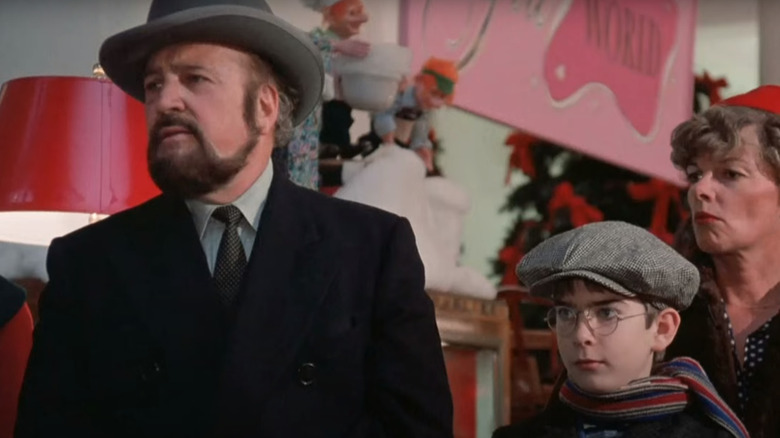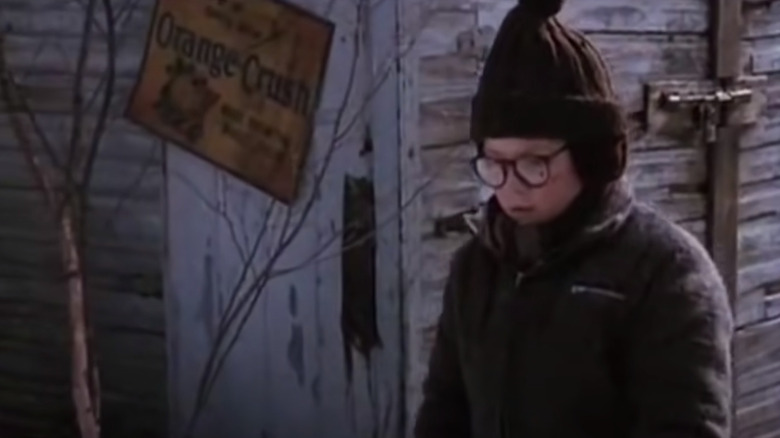Did Jean Shepherd Write A Christmas Story Based On His Life?
On November 17, 2022, HBO Max will bring back a sequel to one of the most popular Christmas movies of all time (via Parade). "A Christmas Story Christmas" will see Peter Billingsly rehash his role as Ralphie Parker, the central character of the original 1983 film "A Christmas Story." Other original actors are set to reprise their roles as well.
As Slate reports, the holiday classic — now shown in reruns for 24 hours a day on Christmas Eve and Christmas Day on TBS — is based somewhat loosely on author Jean Shepherd's book, "In God We Trust: All Others Pay Cash," plus one story published in another volume (per the Los Angeles Review of Books). In the film, Ralphie is the main character, while Shepherd himself, as an adult man, provides the narration.
But how much Jean Shepherd is actually in Ralphie's character? Were the stories in "A Christmas Story" based on Shepherd's own life? As it turns out, the answer exists at the hazy intersection of truth and fiction.
From Jean Shepherd To Ralphie Parker
Jean Shepherd was born on July 26, 1921, and was raised in Hammond, Indiana (via AllMusic). After serving in the U.S. Army during World War II, "Shep," as he was known, took various jobs in radio before making a name for himself at New York City's WOR. Working the night shift, he would amuse listeners with his homespun stories, his clever wordplay on display for the listeners. Slate writer Donald Fagen was a fan. "Shepherd's improvised routines were more in the tradition of Midwestern storytellers like Mark Twain, but with a contemporary, urban twist ... Shepherd, with his warm, charismatic voice and folksy style, could perform his most subversive routines with the bosses in the WOR front office and the FCC being none the wiser. At least, most of the time," he wrote.
Eventually, Shepherd's radio bits became written bits in Playboy, and then, later still, book deals. Director Bob Clark hit upon the idea to base a film on Shepherd's stories, and "A Christmas Story" was born (per Variety). Shepherd provided the narration and even made a cameo in the film: That's him in the screenshot above, telling Ralphie to go to the back of the line in the famed Santa Claus scene.
You've Misunderstood 'A Christmas Story' For Decades
You may be tempted to remember "A Christmas Story" as a heartwarming and uplifting holiday classic filled with positive messages. And though it does contain some warmth and sentimentality and has a happy ending, neither "A Christmas Story" nor Jean Shepherd's stories on which it was based are about schmaltz or the feels. Look closely enough at the characters, the settings, and the stories, and you can see that the movie and the stories on which it's based come from a sharp edge.
Ralphie (above) and his preteen crew, for example, have potty mouths, torment each other, and try to toe the line as far as how much trouble they can get into and get away with. Hohman is beset by poverty and decay. That was all pure Shepherd, writes Lee Vinsel for the LA Review of Books. "In some ways, [Shepherd's] sense of humor and comedic social commentary fit with the so-called 'serious' and 'sick' humor of the 1950s, which took cynical aim at social conformity and the grim," they note.
The whole thing could be considered a metaphor for obsession and how it ultimately lets us down. Ralphie was obsessed with the Little Orphan Annie secret decoder ring, only to learn it was a "crummy commercial." The Old Man is obsessed with Christmas turkey, only to have it eaten by the neighbors' dogs. Ralphie is obsessed with his BB gun, only to shoot his eye out.
The General Structure Is There
Just how much, if any, of Jean Shepherd's stories that informed "A Christmas Story" is true is going to be next to impossible to nail down with any certainty. That's because, for one thing, Jean Shepherd was a storyteller, not a biographer (per Slate); a well-crafted story doesn't need to be true to be good, after all. For another, the only people who know for certain if, for example, Jean's father won a "major award" that turned out to be a kitschy prop ("the soft glow of electric sex") are Jean and his father, and they've both been in their graves for decades.
However, the general structure of "A Christmas Story," as it relates to Shepherd's life, is true. For example, Shepherd was born in 1921 and would have been roughly Ralphie's age in 1931 (via AllMusic), at the tail end of the Great Depression (as rendered non-specifically in the film). He was raised in Hammond, Indiana, replaced by the fictional Hohman ("Midwestern Anytown, USA," as Variety describes it) for the film. Warren G. Harding Elementary School, where Flick famously froze his tongue to a flagpole, is real, and Shepherd attended school there (per Indiana Public Media). Also real is Shepherd's boyhood home on Cleveland Street, and though it's not the same house as used in the film, it is definitely a lower-middle-class family home, as depicted in the movie.
Differences Between The Book And The Film
In addition to parsing out the differences between Jean Shepherd's life and what wound up on the screen via "A Christmas Story," there's also the matter of the differences between the words Shepherd wrote on the page and what was depicted in the film. Lit Reactor's Peter Derk took a look at the differences between the book(s) and the film, and they're subtle. For example, the movie excises the opening exposition sequence in which an adult Ralphie arrives at Hohman and quaffs a few drinks at Flick's bar. Ralphie gets a pair of pink bunny slippers, but not the whole outfit (and is not made to model them). The department store Santa is crotchety and exasperated, but he does not, however, kick Ralphie in the head.
"If you love the movie to death, I think you'll find a lot to enjoy in 'In God We Trust: All Others Pay Cash.' If you're into humorous recollections of a 1950's Midwestern childhood that occasionally veer into 'walked to school uphill both ways in the snow' territory, you'll dig it," writes Derk.




